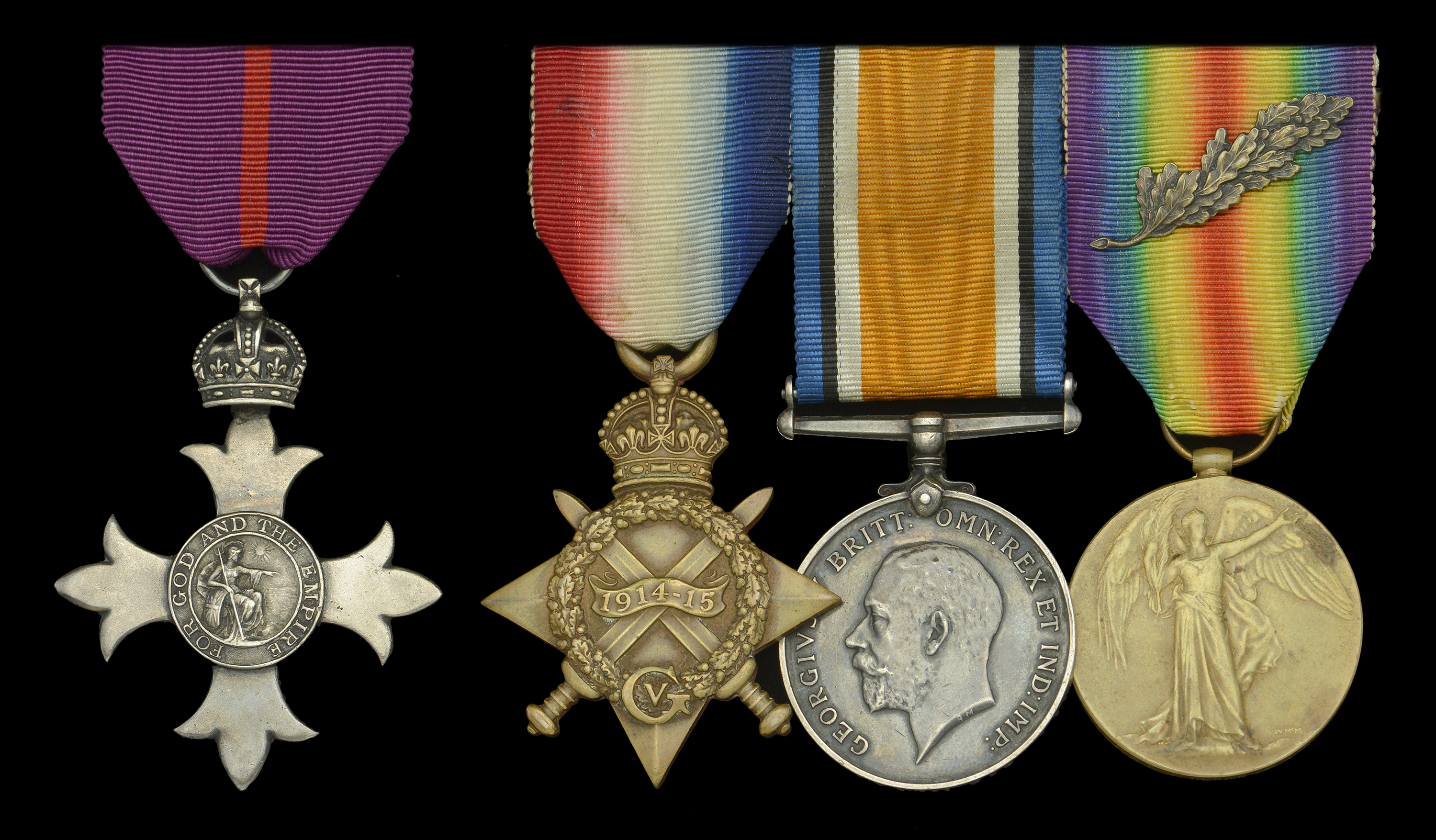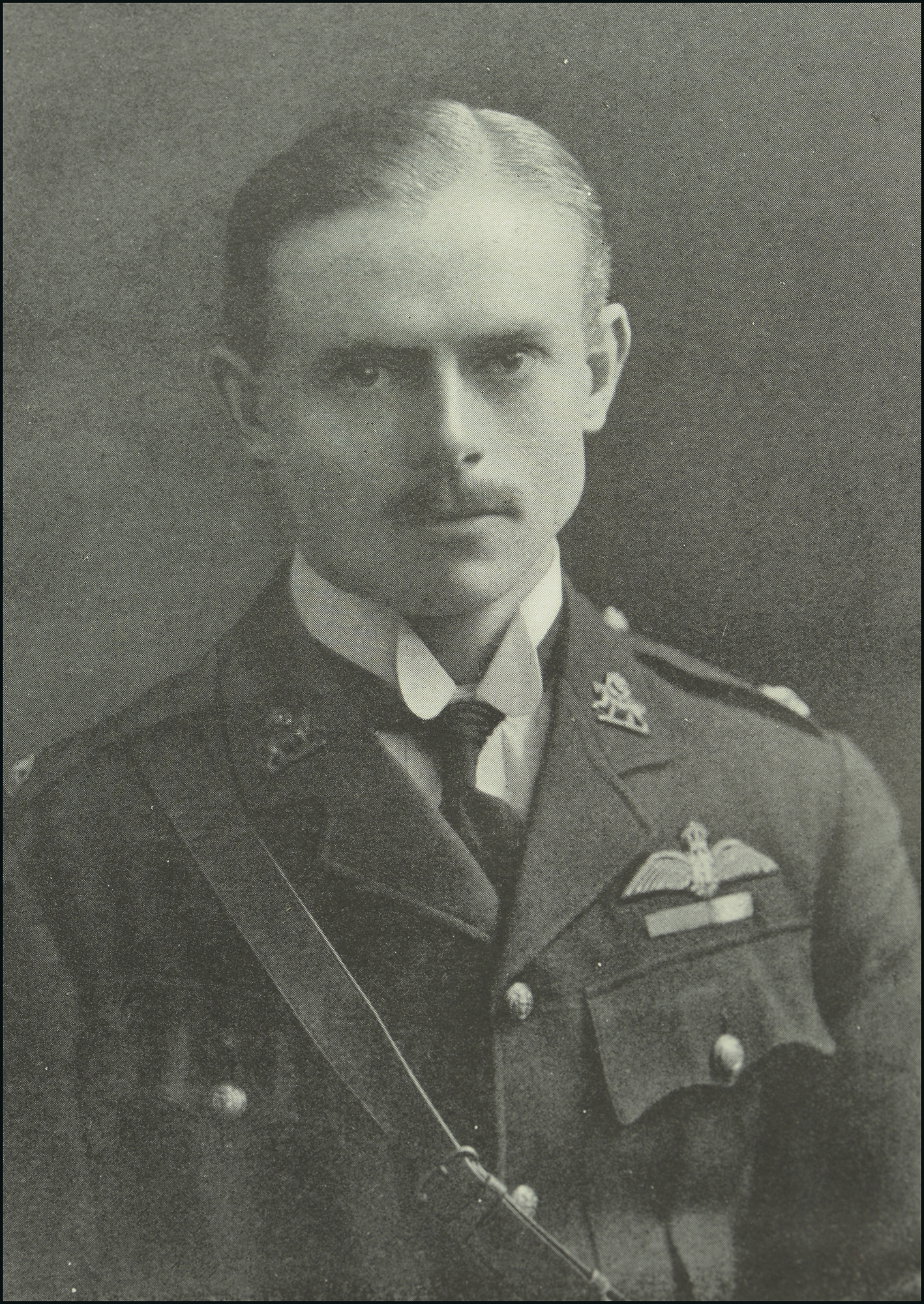“Pilots and Observers, always full of determination and keenness, unselfish and cheerful at all times, won for themselves and the Squadron the greatest admiration. Like gentlemen and sportsmen, they played the game throughout. The every day order of our much respected Chief - General Trenchard - to “keep going” was carried out to the letter....” (Recipient reflecting on his command in The Annals of 100 Squadron) The fascinating Great War O.B.E. group of four awarded to Wing Commander C. G. Burge, Royal Flying Corps and Royal Air Force, both observer and pilot; commanding officer of 100 Squadron, June - December 1918; respected aviation author - including the Squadron History for the Great War; one time personal assistant to Lord Trenchard; Head of an S.O.E. Intelligence Subsection dealing with planning operations, and acting as Liaison with the Air Ministry on all targets during the Second World War; and Uncle of the legendary Battle of Britain fighter Ace Douglas Bader The Most Excellent Order of the British Empire (O.B.E.), (Military) Officer’s 1st type, silver (Hallmarks for London 1919); 1914-15 Star (Lieut. C. G. Burge. York & Lanc. R.); British War and Victory Medals, with M.I.D. oak leaves (Major C. G. Burge. R.A.F.) medals mounted for wear, generally very fine or better (4) £800-£1,200 --- O.B.E. London Gazette 1 January 1919. M.I.D. London Gazette 1 January 1916. Cyril Gordon Burge was an early, if not the first, Adjutant to R.A.F. Cranwell (1920-1922), a onetime personal assistant to Lord Trenchard (from August 1926), and the ‘exciting and friendly uncle’ who actively encouraged the legless ace Sir Douglas Bader to set out on his legendary career. The son of a J.P. for the Cinque Ports, Burge was born in May 1893 and was educated at St Lawrence’s College and Sandhurst. Described as a natural ‘gentleman, leader & organiser’, he was commissioned into the York and Lancaster Regiment in 1913 and was posted to the overseas battalion in India. Promoted Lieutenant on 28 October 1914, he joined the Royal Flying Corps in 1915 and first flew as an Observer with 12 Squadron (R.E.7’s) on the Western Front. It did not take long for Burge to be chucked in at the deep-end, when on 12 October 1915: ‘Capt. Lawrence and Lt Gordon Burge of No. 12 Squadron in a R.E.7 with 2 Lewis guns when engaged in guarding Capt. Christie who was employed on a special mission engaged an Albatross 3 miles South of Lille. Simultaneously another hostile machine appeared and drew in on the left rear of the R.E.7. Both these hostile machines seemed to be slower than the R.E.7. Lt. Burge engaged the Albatross which was the nearer of the two and when just West of Tournai it threw out two white lights. No anti-aircraft gun fire followed this. In a few seconds two more lights were thrown out, again without effect. Both of these hostile machines fired a good deal at the R.E.7. When near Mouscron 2 more machines appeared from above and coming from the South. The first, an Albatross, began to draw up on the left rear firing very accurately. The R.E.7 was struck 30 or more times. When he was at between 50 and 80 yards range Lt Burge fired and this Albatross drew away. He came up again and after firing at it again went away. This occurred a third time when near Gheluvelt and the German machine went away to the South. Meanwhile another machine, an L.V.G. had remained further off and above the R.E.7 firing a good deal. The two machines originally encountered were gradually left behind.’ (Squadron War Diary refers) Burge, this time piloted by Second Lieutenant R. Newman, had to make a forced landing whilst out on patrol, 5 December 1915. Later he trained as a pilot, and according to Bader’s biographer ‘Laddie’ Lucas, saw ‘much of the fighting with the Royal Flying Corps over France and Flanders’. By February 1918 he had accumulated 450 flying hours, and commanded 100 Squadron (F.e.2b’s and later HP O/400’s as part of Independent Force), June - December 1918. Indeed he later wrote the Squadron History for the Great War - The Annals of 100 Squadron, with a foreword being provided by Lord Trenchard (the squadron was in Trenchard's chain-of-command from its formation until the end of the war in Nov 1918). In August 1919 he was granted a Permanent Commission in the R.A.F. with the rank of Lieutenant and was subsequently appointed Adjutant at the former R.N.A.S. air station west of Sleaford in Lincolnshire where the elite officer cadre of the fledgling service was to be trained. Meantime, he married Hazel McKenzie, sister to Douglas Bader’s mother. In the spring of 1921 the boy Bader was invited by the Burges to spend part of the Easter holidays with them at Cranwell. ‘From Hazel and Cyril the welcome was warm. Only just thirteen, Douglas had never been near aeroplanes before, and when the quiet, good-humoured Cyril sat him in the cockpit of an Avro 504 trainer the thick hair almost vanished as the boy bent over the controls and dials like a terrier. Later he stood for hours in Cyril’s garden watching the bellowing Avros taking off over his head ... Cyril thought he had a convert then but he was a little premature ....’ Five years later at St Edward’s School in Oxford Bader was cautiously considering a university career when the visit of an Old Boy then at Cranwell, reminded Bader of his enjoyable stay there, and he wrote at once to ‘Uncle Cyril’ to find out about becoming a Cranwell cadet. Burge had left the R.A.F. College but was then personal assistant to Air Chief Marshal Sir Hugh Trenchard, Chief of the Air Staff, and ‘with the satisfaction of a match-maker, Cyril wrote back saying that Douglas was just the type they wanted and he would do everything he could to help which from the p.a. to the C.A.S., sounded considerable.’ Well primed by Burge, Bader duly presented himself before the board of interviewers for Cranwell at Burlington House in London in June 1928, and, ‘trying not to sound to well rehearsed’, successfully gave the answers ‘Uncle Cyril’ knew the board wanted to hear. The following December Burge retired from the service with a gratuity and over the next few years wrote several published works on British aviation. Following Bader’s famous crash at Woodley Aerodrome, near Reading, on 14 December 1931, Burge was immediately summoned from nearby Aldershot. He reached the Royal Berkshire Hospital to find that the surgeon Leonard Joyce had removed Bader’s right leg and that his nephew’s life was hanging in the balance. Burge was given a room for the night, and twice when it seemed that Bader was dying was called to the patient’s room but on each occasion Bader rallied. In the morning Bader was still alive but had not recovered consciousness since the amputation of his largely severed right leg. Joyce told Burge that if Bader lasted another day he might have a chance provided the left leg did not become sceptic. At length Bader came round, and, examining him, Joyce recognised signs of incipient septicaeima in the left leg. With Bader’s mother close to hysteria and with no time to lose, Joyce sought Burge’s permission to cut off the remaining leg, warning him that Bader would certainly die if the leg stayed, and that he would probably die from operative shock if they tried to take it off. It was the only chance and Burge instantly nodded his assent. With family trials over, Burge then embarked on a period of drama of his own making. His S.O.E. Personnel History Sheet (released in 2003) gives the following with regards to his application to join the service, and in what capacity he was eventually emp...






